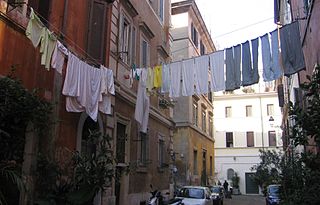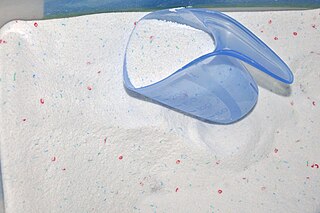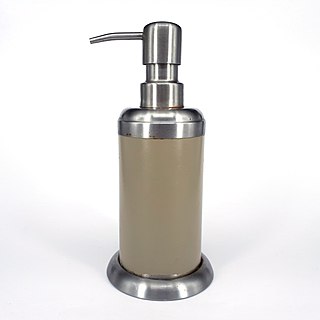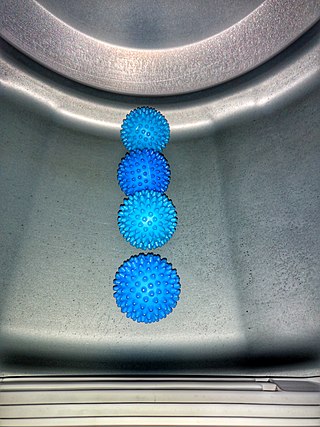
Laundry refers to the washing of clothing and other textiles, and, more broadly, their drying and ironing as well. Laundry has been part of history since humans began to wear clothes, so the methods by which different cultures have dealt with this universal human need are of interest to several branches of scholarship.

A washing machine is a home appliance used to wash laundry. The term is mostly applied to machines that use water as opposed to dry cleaning or ultrasonic cleaners. The user adds laundry detergent, which is sold in liquid, powder, or dehydrated sheet form, to the wash water.

Dry cleaning is any cleaning process for clothing and textiles using a solvent other than water.

A clothes dryer, also known as tumble dryer or simply dryer, is a powered household appliance that is used to remove moisture from a load of clothing, bedding and other textiles, usually after they are washed in a washing machine.

A clothes line, also spelt clothesline and also known as a washing line, is a device for hanging clothes on for the purpose of drying them. It is any type of rope, cord, or twine that has been stretched between two points, outside or indoors, above the level of the ground. Clothing that has recently been washed is hung along the line to dry, using clothes pegs or clothespins. Washing lines are attached either from a post or a wall, and are frequently located in back gardens, or on balconies. Longer washing lines often have props holding up sections in the middle due to the weight of the usually wet clothing.
A fabric softener or fabric conditioner is a conditioner that is applied to laundry after it has been washed in a washing machine. A similar, more dilute preparation meant to be applied to dry fabric is known as a wrinkle releaser.

Laundry detergent is a type of detergent used for cleaning dirty laundry (clothes). Laundry detergent is manufactured in powder and liquid form.

Asko Appliances AB was a Swedish company producing household appliances such as refrigerators, dishwashers and washing machines. It was based in Jung in Vara Municipality in Västergötland. Asko Appliances is now owned by Gorenje Group which is a part of Chinese major appliances manufacturer Hisense. The products continue to be sold in Sweden under the brand Cylinda and Asko. In North America, Asko imports only dishwashers and laundry appliances. Asko is upscale and competes against Bosch, Miele, SMEG, Viking Range, Fulgor and Kitchen Aide Electrolux.

A laundry ball or washing ball is a product made of solid, insoluble material promoted as a substitute for laundry detergent. Producers of laundry balls often make pseudoscientific claims about their mechanisms of action and exaggerate the extent of their benefits.

A soap dispenser is a device that, when manipulated or triggered appropriately, dispenses soap. It can be manually operated using a handle or can be automatic. Soap dispensers are often found in public toilets.

A Pythagorean cup is a practical joke device in a form of a drinking cup, credited to Pythagoras of Samos. When it is filled beyond a certain point, a siphoning effect causes the cup to drain its entire contents through the base. The cup can be used to learn about greed.

A combo washer dryer is a combination in a single cabinet of a washing machine and a clothes dryer. It should not be confused with a "stackable" combination of a separate washing machine and a separate clothes dryer.

A dryer ball is a spherical laundry device for tumbling clothes dryers used as an alternative to fabric softener, reducing static electricity or softening clothing, or to accelerate the drying process.

An automatic soap dispenser is a device that dispenses a controlled amount of soap solution. They are often used in conjunction with automatic faucets in public restrooms. They function to conserve the amount of soap used and stem infectious disease transmission.
Dimensional stability pertains to a fabric's ability to maintain its initial size and shape even after undergoing wear and care, which is a desirable property. Dimension stability in fabrics or Shrinkage is the change of dimensions in textile products when they are washed or relaxed. The change is always expressed relative to the dimensions before the exposure of washing or relaxing. Shrinkage is also called residual shrinkage and measured in percentage. The major cause of shrinkages is the release of stresses and strains introduced in manufacturing processes. Textile manufacturing is based on the conversion of fiber into yarn, yarn into fabric, includes spinning, weaving, or knitting, etc. The fabric passes through many inevitable changes and mechanical forces during this journey. When the products are immersed in water, the water acts as a relaxing medium, and all stresses and strains are relaxed and the fabric tries to come back to its original state.

Fabric treatments are processes that make fabric softer, or water resistant, or enhance dye penetration after they are woven. Fabric treatments get applied when the textile itself cannot add other properties. Treatments include, scrim, foam lamination, fabric protector or stain repellent, anti microbial and flame retardant.














